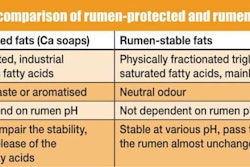The cow-calf stage is the most significant contributor of greenhouse gases during beef production, according to a paper for the Journal of Animal Science which showed that overall beef production has a carbon footprint ranging from 10.7 kg to 22.6 kg of carbon dioxide equivalent per kg of hot carcass weight.
In the cow-calf phase, the cow gives birth and nurses the calf until the calf is six to 10 months old. During this time, the cow eats rough plants like hay and grasses. The methane-producing bacteria in the cow’s gut thrive on these plants. ”The more roughage is in the diet of the ruminant animal, the more methane is produced by the microbes in the gut of the ruminant, and methane comes out the front end,” said study co-author Frank Mitloehner, an associate professor in the Department of Animal Science at UC Davis. In feedlots, by contrast, cattle eat mostly corn and grains, which the methane-producing bacteria cannot use as effectively.
Greenhous gas emissions are something the beef industry has been paying close attention to in recent years. ”We are doing a lot to measure and mitigate our impact,” said Chase Adams, director of communications for the National Cattlemen’s Beef Association. In a 2011 paper for the Journal of Animal Science, researcher Jude Capper showed that the beef industry today uses significantly less water and land than 30 years ago. The industry has also reduced its carbon footprint by 16.3 percent per billion kilograms of beef produced.
According to Mitloehner, beef producers can further reduce their carbon impact by using new technologies like growth promotants. However, consumers are often uncomfortable with these methods, and they choose organic beef or beef with reduced amounts of growth promotants. ”The technologies many consumers are critical of are those that help us receive the greatest environmental gains,” said Mitloehner.















